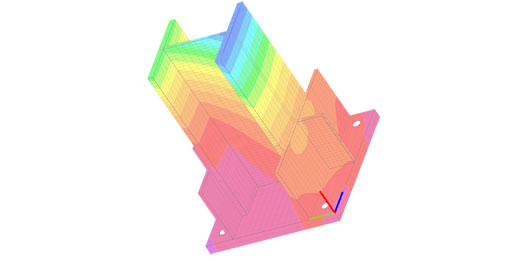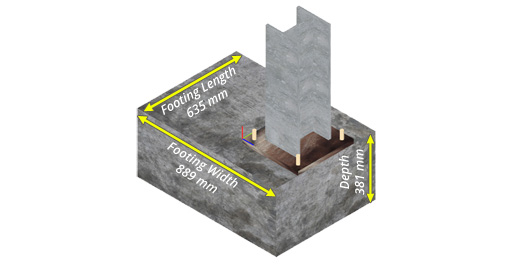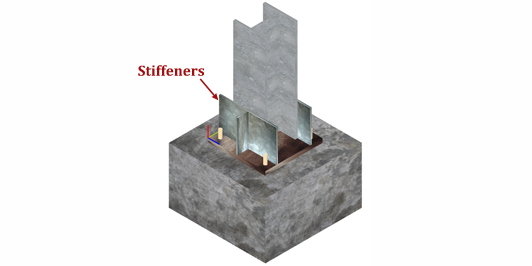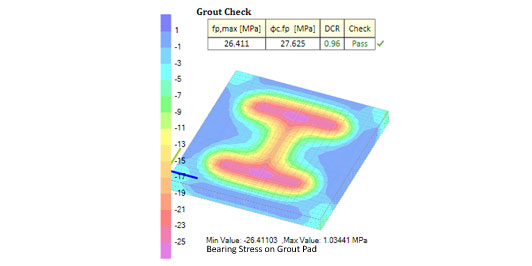- New Study Highlights Economic Earthquake Risk in the United States 20 April 2023 Earthquakes cost the nation an estimated $14.7 billion annually in building damage ...
- AISC Releases 2022 Code of Standard Practice for Steel Building and Bridges Nov 24, 2022 AISC has released the latest revision of one of its flagship standards, the Code ...
- High-Rise in Milwaukee Takes Title of World’s Tallest Mass Timber Hybrid July 24, 2022 On July 20, 2022 New Land Enterprises welcomed the Council on Tall Buildings and ...
- Tornado Effects - New Chapter in ASCE7-22 March 29, 2022 The new edition of ASCE’s Minimum Design Loads and Associated Criteria for ...
- A large earthquake near Acapulco shakes Mexico’s capital Sep 7, 2021 At least one death was reported after a 7.1 magnitude temblor struck on Tuesday ...
- Additional Details Revealed about Surfside Condo Prior to Collapse June 30, 2021 Just weeks before Champlain Towers South collapsed, town officials in Surfside, ...
- Download Code of Standard Practice for Structural Stainless Steel Buildings (AISC 313) July 21, 2020 The new AISC Code of Standard Practice for Structural Stainless Steel Buildings ...
- Lender Halts Funding for Skyscraper in Chicago's Downtown Due to Pandemic July 12, 2020 A Helmut Jahn-designed skyscraper along South Michigan Avenue is on hold at least ...
- Two High-Rise Projects Eyed for Office Plaza in Dallas Apr 14, 2020 The owners of two key properties in North Dallas’ Preston Center business ...
- Skyscraper Projects in Chicago’s Near West Side Move Forward Dec 21, 2019 Global architecture firm Goettsch Partners (GP) announced the groundbreaking on ...
- Revised Design for San Francisco Tower Submitted Dec 10, 2019 The proposed tower on Transbay Parcel F, in downtown San Francisco, has gone ...
- Historical Earthquake Impact Affected by Seasonal Factors Nov 10, 2019 The season that an earthquake occurs could affect the extent of ground failure and ...
- Planned Skyscraper Above Boston Rail Station Moves Forward Oct 25, 2019 South Station Tower is planned to rise 677 feet (206.4 meters) above South Station, ...
- California 6.4 earthquake felt in Los Angeles and Las Vegas July 4, 2019 The strongest earthquake to hit Southern California in nearly 20 years left ...
- Chicago to See a New Skyscraper on Michigan Avenue March 31, 2019 One of Chicago’s busiest real estate developers wants to build a 47-story ...
- “Tower Fifth” Could Become New York City’s Second-Tallest Jan 23, 2019 For decades, the New York City skyline was dominated by one building, the ...
- Yousef Bozorgnia Selected as 2019 Bruce Bolt Medal Recipient Jan 9, 2019 The Consortium of Strong Motion Observation Systems (COSMOS), Earthquake Engineering ...
- A Mixed-Use Complex With a 300-Meter Tower Starts Construction in Changchun Dec 22, 2018 Goettsch Partners (GP) has announced the start of construction for Changchun CR ...
- Historic Earthquakes Test Indonesia’s Seismic Hazard Assessment Dec 16, 2018 Using data gleaned from historical reports, researchers have now identified the ...
- City of Edmonton Approves Two Condo Towers Nov 29, 2018 The City of Edmonton has approved the construction of two tall condo towers that ...
- Call For Papers 2019 Pacific Structural Steel Conference Nov 23, 2018 The 2019 Pacific Structural Steel Conference (PSSC '19) is accepting abstracts ...
- 2018 International Green Construction Code Released Nov 13, 2018 The International Code Council, ASHRAE, the U.S. Green Building Council (USGBC) and ...
- Location of Wastewater Disposal Drives U.S. Induced Seismicity Nov 01, 2018 The depth of the rock layer that serves as the disposal site for wastewater ...
- Seismic Signals of Navy Test Explosions off Florida Coast Oct 17, 2018 Underwater explosions detonated by the U.S. Navy to test the sturdiness of ...
- New AISC Design Guide Focuses on Curved Steel Design Available, AISC Design Guide 33 Oct 12, 2018 Despite the widespread use of curved structural steel members, detailed guidance ...
- New Edition of AISC Welded Connections Design Guide 21 Available Oct 10, 2018 The second edition of AISC Design Guide 21: Welded Connections – A Primer for ...
- Free Download New Report on System Redundant Members for Steel Bridges Sep 30, 2018 A new report on developments in the analysis of steel bridge system redundant ...
- Seasonal Reservoir Filling in India Deforms Rock, May Trigger Earthquakes Sep 28, 2018 The seasonal filling and emptying of reservoirs in India can cause measurable ...
- Explosion, Collapse, Earthquakes: Analysis of North Korea’s 2017 Nuclear Test Sep 27, 2018 The epicenter of the 3 September 2017 nuclear test explosion in North Korea ...
- What is the new 3rd Edition AISC Seismic Design Manual? Sep 24, 2018 The 3rd Edition AISC Seismic Design Manual has been expanded with additional ...
- 60-Story Mixed-Use Tower to Transform Watamu, Kenya Skyline Sep 20, 2018 The small town of Watamu in Kenya is best known for tourism and fishing, ...
- New Edition of AISC Seismic Design Manual Available Sep 12, 2018 Designers and fabricators can now access the most comprehensive information for ...
- Crack Appears in Sinking San Francisco Tower’s Window Sep 07, 2018 A large crack formed in a window at the sinking and tilting Millennium Tower in San ...
- Caracas Skyscraper Damaged by Earthquake, Aug 22 Aug 24, 2018 The Torre de David, a 45-story unfinished skyscraper in Caracas, which is also ...
- Massive earthquake near Sucre, Venezuela, M7.3 Aug 22, 2018 The August 21, 2018, M 7.3 earthquake near the northern coast of Venezuela ...
- Guadalajara Tower Construction Terminated Following Adjacent Property Collapse Aug 18, 2018 The Guadalajara City Council announced the indefinite suspension of construction on ...
- Fatal Italian Bridge Collapse Is Under Investigation Aug 15, 2018 A 50-year-old cable-stayed concrete bridge, one of the first of its type in Europe, ...
- Two New Towers to be Delivered in Surabaya, Indonesia July 10, 2018 In the midst of a difficult property market, PT PP Properties Tbk continues to ...
- 235-Meter High-Rise in Buenos Aires Slated to Become Argentina’s Tallest July 7, 2018 Located in the heart of Buenos Aires’ Puerto Madero sector, the ...
- International Collaboration Studies the Predictability of Earthquakes June 23, 2018 Since 2007, the Collaboratory for the Study of Earthquake Predictability or ...
- Tall wood buildings on the rise for Canadian universities June 22, 2018 The University of Toronto has unveiled plans to construct a 14-story wood building ...
- Energy Efficient Office Tower to Join Toronto’s Skyline June 19, 2018 A 46-story office tower will be constructed in Toronto’s downtown. Slated ...
- First Residents to Move into Melbourne’s Australia 108 Tower June 15, 2018 Construction of what will likely become the tallest residential tower in the ...
- 122nd Anniversary of the Destructive Sanriku Earthquake, Japan 15 June 2018 A destructive earthquake occurred at 19:32 (local time) on June 15, 1896, 166 ...
- Earthquake Safe: 30 Years of Innovation at UC San Diego June 13, 2017 When you drive across a highway bridge in California, there is a good chance ...
- Third World Trade Center Skyscraper Opens June 11, 2018 After years of disputes whether the site of 9/11 should be preserved as a memorial ...
- A High-Rise University Campus in Madrid is Under Construction June 10, 2018 A building designed by the architectural firm Fenwick Iribarren is under ...
- Construction projects for US National Parks June 9, 2018 The US Interior Department has announced $256 million in funding for the ...
- Supertall Skyscraper Proposed for Punta del Este Site June 7, 2018 A new tourism complex on the San Rafael Site in Punta Del Este has been ...
- Binghatti Crystals structure complete; facade and finishing underway June 4, 2018 Binghatti Developers has completed the structure works on its ...
- Dubai Creek Tower Pile Cap Construction Complete June 1, 2018 Concrete placement work for Dubai Creek Tower's pile cap has been completed two ...
- Beirut's Burj El Murr, An Unfinished Skyscraper, Has Been Decorated May 31, 2018 Burj El Murr, the unfinished skyscraper that has loomed over Beirut for the past 40 ...
- San Francisco Reviews Seismic Code for Tall Buildings May 28, 2018 Sailors arriving in San Francisco in the 19th century used two giant redwood trees ...
- How Big Can a Tsunami Be in the Caribbean? May 25, 2018 The 2004 Indian Ocean tsunami has researchers reevaluating whether a magnitude 9.0 ...
- Modeling Future Earthquake and Tsunami Risk in Southeast Japan May 24, 2018 Geoscience researchers unveil new, GPS-based methods for modeling ...
- Overview of The Great Chilean Earthquake In The 58th Anniversary 23 May 2018 On May 22, 1960, at 7:11 in the evening, the strongest earthquake ever recorded in ...
- Millennium Tower in San Francisco is leaning and sinking 22 May 2018 Huge cracks spreading in the building's basement force its residents ...
- Flood-resistant buildings: a concept-project for the city of New York 21 May 2018 These flood-proof towers could withstand rising sea levels in New York? The ...
- Evaluating Active Pressure Management of Induced Earthquakes 20 May 2018 Can altering the amount or rate of fluid injection and production in an oil and gas ...
- Researchers turn carbon dioxide into sustainable concrete 19 May 2018 Imagine a world with little or no concrete. Would that even be possible? After all, ...
- Unlocking the secrets of creeping concrete 18 May 2018 Researchers have clarified the origins of a mechanism responsible for the gradual ...
- New Edition of Rehabilitation and Retrofit Design Guide (AISC DG15) Available 15 May 2018 The second edition of AISC’s Design Guide 15: Rehabilitation and Retrofit ...
- Influence of base plate bending stiffness on the seismic performance of liquid storage tanks 14 May 2018 Procedia Engineering Volume 199, 2017, Pages 170-175 By Diego ...
- How machine learning helped Surrey develop a new algorithm that could add more life to bridges 14 May 2018 A new algorithm developed by the University of Surrey could help structural ...
- Stanford expert describes Hawaii’s most active volcano and the science behind the latest eruptions 12 May 2018 Hawaii’s Kilauea volcano has been oozing lava for more than three ...
- 500-year-old Leaning Tower of Pisa mystery unveiled by engineers 11 May 2018 Why has the Leaning Tower of Pisa survived the strong earthquakes that have hit the ...
- Multiple uses for empty plastic bottles during disaster relief and beyond 10 May 2018 Powerful hurricanes and earthquakes have wreaked havoc in the United States and ...
- Strong earthquake in Pakistan injures at least 26 children 9 May 2018 At least 26 children were injured due to stampede following feeling the shaking of ...
- 2019 Milek Fellowship Call for Proposals Now Open 08 May 2018 Chicago — University faculty are invited to apply for the 2019 AISC Milek ...
- Scientists create innovative new 'green' concrete using graphene 30 April 2018 A new greener, stronger and more durable concrete that is made using the ...
- Engineers develop technique to make adaptive materials 20 April 2018 Engineers have developed a technique that causes a composite material to become ...
- Digital Version of 15th Edition Steel Construction Manual Now Available 11 April 2018 The digital version of AISC’s 15th Edition Steel Construction Manual is now ...
- Earthquake Report: M 7.9 - 280km SE of Kodiak, Alaska 24 January 2017 Tectonic Summary The January 23, 2018 M 7.9 earthquake southeast of Kodiak ...
- Introduction to Paper: Stability of Steel Columns Subjected to Earthquake and Fire Loads 23 January 2018 By: Mehrdad Memari, A.M.ASCE; Hussam Mahmoud, M.ASCE; and Bruce Ellingwood, ...
- Concrete Compression Testing Machines that best fit your compression testing needs. 19 January 2018 Gilson makes it easy to build the concrete compression machine that best fits ...
- Introduction to Paper: Hysteretic Model for Exposed Column Base Connections By: Pablo Torres Rodas, S.M.ASCE; Farzin Zareian; and Amit Kanvinde, ...
- Amit Kanvinde Named As Huber Prize Winner From ASCE; The Structural Engineering Institute of the American Society of Civil Engineers is ...
- Hayward Baker works on iconic US landmark When a St Louis contractor ran into an unexpected problem on the site of one of America’s ...
- A Five Year Forecast For Increased Global Seismic Hazard BILHAM, Roger, Geological Sciences and CIRES, the University of Colorado at Boulder, UCB 399, ...
- Iran's Earthquake, Deadliest in 2017 On 12 November 2017 at 18:18 UTC (21:48 Iran Standard Time, an earthquake with a moment magnitude ...
- 2018 Fazlur Rahman Khan Distinguished Lecture Series October 26, 2017 In step with the abounding vitality of the time, structural engineer Fazlur ...
- Discarded plastic bottles could be used to make stronger concrete 25 October 2017 MIT students have found a way to produce plastic-reinforced concrete that is up ...
- SUT to Lead National Earthquake Simulation and Retrofitting Studies For the first time in the country and the third time in the world, by doing destructive tests on ...
- 2017 SE Research Showcase Day From ASCE; Website: SE Research Showcase Day Website Register Now Event Date: Feb 23, ...

Aug 15, 2018
A 50-year-old cable-stayed concrete bridge, one of the first of its type in Europe, collapsed August 14 in the Italian city of Genoa. Early reports say that multiple fatalities occurred when the bridge fell during a heavy storm.
Image taken August 14 showing collapse of a portion of the Polcevera viaduct in Genoa, Italy.
The bridge — which carried the A10 motorway across a river, railroad tracks and numerous structures — was built between 1963 and 1967 by the Italian Society for Water Pipelines. It was designed by Italian engineer Riccardo Morandi.
The Polcevera viaduct had a length of 1,102 m (3,615 ft), a height of 45 m (148 ft) on the road level and three reinforced concrete piers that rose 90 m (300 ft) in height. The maximum span was 210 m (690 ft).

Image of the viaduct prior to its partial collapse.
Local news reports said that the bridge was under repair. The country's transport minister said that the bridge had shown "signs of problems" in the past.
Major repairs were made to the bridge between 1992 and 1994 after inspections showed that concrete stays had degraded, particularly around a bridge element known as pylon 11. A general restoration project was taken on, including structurally reinforcing the concrete stays of pylon 11.
The cause of the bridge's collapse remains under investigation, and there was no indication as to whether the 25-year-old repairs were a factor.
The repairs added both long and short cables for each concrete stay. The long cables were located along the vertical faces of the concrete stays and were linked to them by means of steel ties that were fixed on the top of the pylon to steel caps. They were also fixed under the bottom of the transverse beam to steel plates.
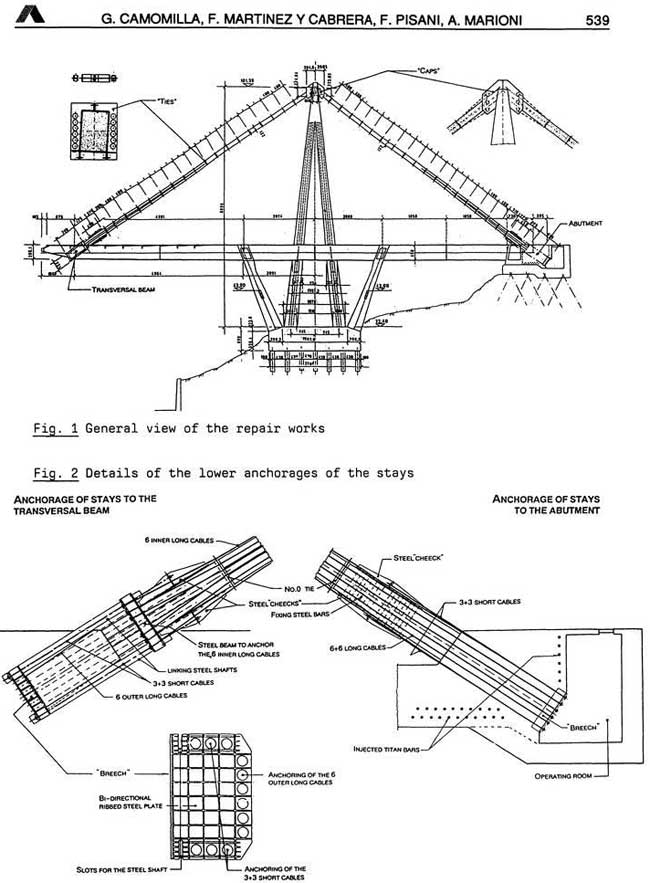
Image of the viaduct prior to its partial collapse.
The short cables were located on the sub-horizontal faces of the concrete stays and were fixed to the lower parts of the concrete stays by way of steel checks.
A report compares the long cables to the main tendons of the concrete stays and the short ones to the secondary tendons.
In the repair design, the short cables also had the temporary function to bear all the load of the bridge as the old strands were cut away. More permanently, they helped to regulate the stress level in the concrete stays.
The replacement stay cables were made with unbonded strand encased in an high-density polyethylene duct. Their design allowed for them to be checked, tension regulated and replaced either altogether or strand by strand.
Part of a Morandi-designed bridge in Venezuela, which was built using a similar design to the one in Genoa, collapsed in 1964 after being hit by a ship.
Reference:
https://insights.globalspec.com/article/9596/fatal-italian-bridge-collapse-is-under-investigation
Keywords: Italian Bridge Collapse Construction
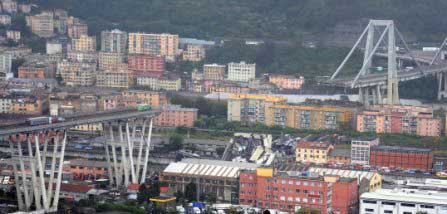

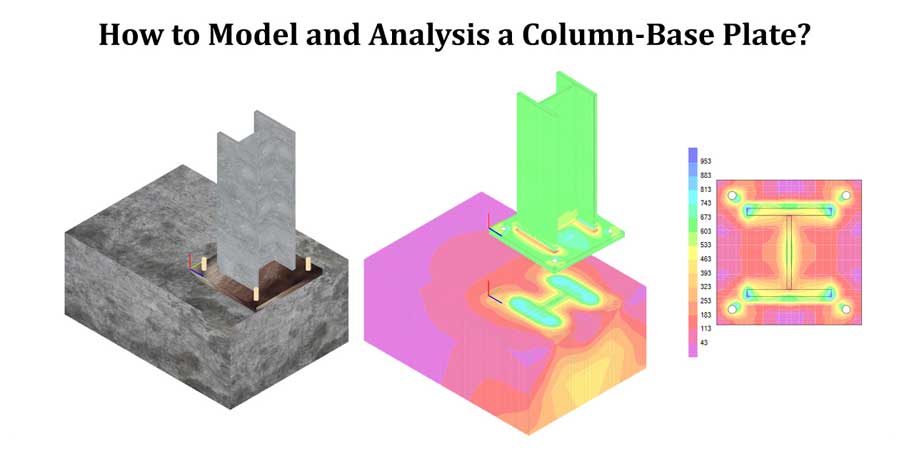 How to Model and Analysis Steel Base Plates
How to Model and Analysis Steel Base Plates
